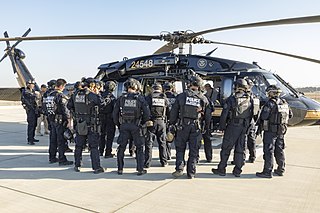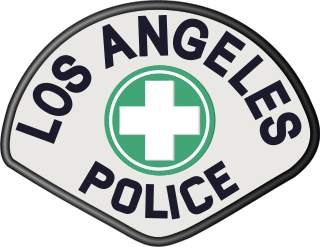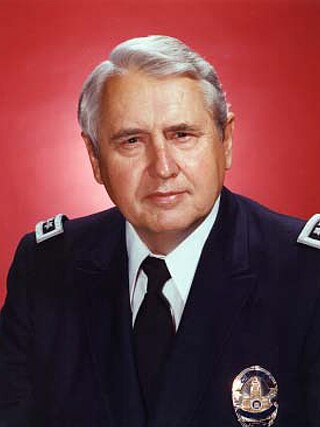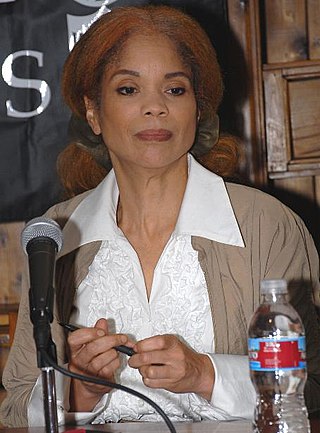
In the United States, a SWAT team is a generic term for a police tactical unit.

The Los Angeles Police Department (LAPD), officially known as the City of Los Angeles Police Department, is the primary law enforcement agency of Los Angeles, California, United States. With 8,967 officers and 3,000 civilian staff, it is the third-largest municipal police department in the United States, after the New York City Police Department and the Chicago Police Department.

Joseph Aloysius Wambaugh, Jr. is a best-selling American writer known for his fictional and nonfictional accounts of police work in the United States. Many of his novels are set in Los Angeles and its surroundings and feature Los Angeles police officers as protagonists. He has been nominated for four Edgar Awards, and was named a Grand Master by the Mystery Writers of America.

Daryl Francis Gates was an American police officer who served as chief of the Los Angeles Police Department from 1978 to 1992. His length of tenure in this position was second only to that of William H. Parker. Gates is credited with the creation of SWAT teams alongside fellow Los Angeles Police Department (LAPD) officer John Nelson, who others claim was the originator of SWAT in 1965. Gates also co-founded the Drug Abuse Resistance Education program.

Edward Michael Davis was the chief of the Los Angeles Police Department from 1969 to 1978, and later a California state senator from 1980 to 1992 and an unsuccessful Republican candidate for the United States Senate in 1986. Davis' name was familiar to a generation of Americans since it appeared on its own card for "technical advice" in the closing credits of the popular television programs Dragnet (1967–70) and Adam-12 (1968–75).
The Fuhrman tapes are 13 hours of taped interviews given by Mark Fuhrman, former detective of the Los Angeles Police Department, to writer Laura McKinny between 1985 and 1994.

A chokehold, choke, stranglehold or, in Judo, shime-waza is a general term for a grappling hold that critically reduces or prevents either air (choking) or blood (strangling) from passing through the neck of an opponent. The restriction may be of one or both and depends on the hold used and the reaction of the victim. While the time it takes for the choke to render an opponent unconscious varies depending on the type of choke, the average across all has been recorded as 9 seconds.
Bloody Christmas was the severe beating of seven civilians by members of the Los Angeles Police Department (LAPD) on December 25, 1951. The attacks left five Mexican American and two white young men with broken bones and ruptured organs, and were properly investigated only after lobbying from the Mexican American community. The internal inquiry by Los Angeles Chief of Police William H. Parker resulted in eight police officers being indicted for the assaults, 54 being transferred, and 39 suspended.
A civil gang injunction or CGI is a type of restraining order issued by courts in the United States prohibiting gang members in particular cities from participating in certain specified activities. It is based on the legal theory that gang activity constitutes a public nuisance that can prevent non–gang members of the community from enjoying peace and public order. An injunction is obtained against the gang itself, after which the police and district attorney may decide against whom they will enforce it upon. Law enforcement use gang injunctions as a tool to label people as gang members and restrict their activities in a defined area (ACLU).
McCleskey v. Kemp, 481 U.S. 279 (1987), is a United States Supreme Court case, in which the death sentence of Warren McCleskey for armed robbery and murder was upheld. The Court said the "racially disproportionate impact" in the Georgia death penalty indicated by a comprehensive scientific study was not enough to mitigate a death penalty determination without showing a "racially discriminatory purpose." McCleskey has been described as the "most far-reaching post-Gregg challenge to capital sentencing."

Constance L. "Connie" Rice is an American civil rights activist and lawyer. She is also the co-founder and co-director of the Advancement Project in Los Angeles. She has received more than 50 major awards for her work in expanding opportunity and advancing multi-racial democracy. She is a second cousin of former U.S. Secretary of State Condoleezza Rice.
Kolender v. Lawson, 461 U.S. 352 (1983), is a United States Supreme Court case concerning the constitutionality of vague laws that allow police to demand that "loiterers" and "wanderers" provide "credible and reliable" identification.
Crime in Los Angeles has varied throughout time, reaching peaks between the 1970s and 1990s. Since the early 2020s, crime has increased in Los Angeles.

Charles Lloyd Beck is a retired police officer, formerly serving as the Chief of the Los Angeles Police Department (LAPD) and subsequently as the Superintendent of the Chicago Police Department. A veteran of the department with over four decades as an officer, he is known for commanding and rehabilitating the Rampart Division after the Rampart scandal; and for technology enhancements during his time as Chief of Detectives. He agreed to be interim Superintendent of Police in Chicago in late 2019 while the city searches nationwide for a replacement for retiring Eddie Johnson. Beck took the helm of the Chicago Police Department on December 2, 2019 after Johnson was fired. On April 15, 2020, Beck stepped down and was replaced by former Dallas Police Department Chief David Brown, who had been nominated by Lightfoot to serve as permanent Superintendent. After his retirement he rejoined the Reserve Corps as a Reserve Police Officer and is assigned to the Office Of The Chief Of Police.

Ezell Ford, a 25-year-old African-American man, died from multiple gunshot wounds after being shot by Los Angeles Police Department (LAPD) officers in Florence, Los Angeles, California on August 11, 2014. In the weeks and months that followed, Ford's shooting triggered multiple demonstrations and a lawsuit by Ford's family claiming $75 million in damages.
Yount v. City of Sacramento was a decision of the California Supreme Court, which significantly expanded the rights of a convicted arrestee subjected to excessive force during arrest. The case was brought by Brian T. Dunn of The Cochran Firm in California, on behalf of Steven Yount when Yount was shot by a Sacramento police officer after being handcuffed during a DUI arrest.

The killing of Charley Leundeu Keunang, a 43-year-old Cameroonian national, occurred in Los Angeles, California, on March 1, 2015. He was shot by three Los Angeles Police Department officers.
James Mincey Jr. died on April 5, 1982, in Los Angeles, California after being placed in a carotid hold while under arrest by the Los Angeles Police Department. While driving home on an early April night in 1982, Mincey Jr. was stopped by police officers for a cracked windshield and was issued a ticket. A few minutes later, a pursuit was initiated after Mincey Jr. failed to stop for the police again. He was acting under the suspicion that the police were harassing him, so he continued driving home. Once home, Mincey Jr. exited his vehicle and was sprayed with "tear gas" in his face. He broke free from the two arresting officer's grips and moved towards his home, while trying to clean his face.










